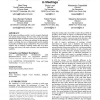Free Online Productivity Tools
i2Speak
i2Symbol
i2OCR
iTex2Img
iWeb2Print
iWeb2Shot
i2Type
iPdf2Split
iPdf2Merge
i2Bopomofo
i2Arabic
i2Style
i2Image
i2PDF
iLatex2Rtf
Sci2ools
ICMI
2007
Springer
2007
Springer
Using the influence model to recognize functional roles in meetings
In this paper, an influence model is used to recognize functional roles played during meetings. Previous works on the same corpus demonstrated a high recognition accuracy using SVMs with RBF kernels. In this paper, we discuss the problems of that approach, mainly over-fitting, the curse of dimensionality and the inability to generalize to different group configurations. We present results obtained with an influence modeling method that avoid these problems and ensures both greater robustness and generalization capability. Categories and Subject Descriptors H.5.3 [INFORMATION INTERFACES AND PRESENTATION]: Group and Organization Interfaces: Computer-supported cooperative work - Synchronous interaction I.2.10. [ARTIFICIAL INTELLIGENCE]: Vision and Scene Understanding – Perceptual Reasoning General Terms Design, Experimentation, Human Factors. Keywords Group Interaction, Support Vector Machines, Intelligent Environments.
| Added | 08 Jun 2010 |
| Updated | 08 Jun 2010 |
| Type | Conference |
| Year | 2007 |
| Where | ICMI |
| Authors | Wen Dong, Bruno Lepri, Alessandro Cappelletti, Alex Pentland, Fabio Pianesi, Massimo Zancanaro |
Comments (0)

